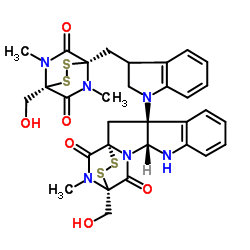Chetomin

Chetomin structure
|
Common Name | Chetomin | ||
|---|---|---|---|---|
| CAS Number | 1403-36-7 | Molecular Weight | 712.882 | |
| Density | 1.8±0.1 g/cm3 | Boiling Point | N/A | |
| Molecular Formula | C31H32N6O6S4 | Melting Point | 710.9ºC | |
| MSDS | Chinese USA | Flash Point | N/A | |
| Symbol |

GHS06 |
Signal Word | Danger | |
Use of ChetominChetomin, an active component of Chaetomium globosum, is a heat shock protein 90/hypoxia-inducible factor 1 alpha (Hsp90/HIF1α) pathway inhibitor. Chetomin is a potent, nontoxic non-small cell lung cancer cancer stem cells (NSCLC CSC)-targeting molecule[1]. |
| Name | chetomin |
|---|---|
| Synonym | More Synonyms |
| Description | Chetomin, an active component of Chaetomium globosum, is a heat shock protein 90/hypoxia-inducible factor 1 alpha (Hsp90/HIF1α) pathway inhibitor. Chetomin is a potent, nontoxic non-small cell lung cancer cancer stem cells (NSCLC CSC)-targeting molecule[1]. |
|---|---|
| Related Catalog | |
| Target |
HSP90 |
| In Vitro | Chetomin (0~10 μM; 24 hours; H460 and H1299 cells) shows progressively lower expression of several survival-promoting proteins promoted by Hsp90/HIF1α activity, including insulin-like growth factor 1 (IGF1 R), epidermal growth factor receptor (EGFR), Src, mitogen-activated protein kinase kinase 1/2 (MEK1/2), activation of protein kinase B (Akt), and mammalian target of rapamycin (mTOR) [1]. Chetomin (0~10 μM; 24 hours; H1299 cells) elicits cell cycle arrest in susceptible and chemoresistant NSCLC cell lines[1]. .Chetomin (1 µM; 3 days; H460 and H1299 cells) pretreatment abolishes their sphere-forming capacity. Chetomin inhibits sphere-forming by NSCLC CSCs within a nanomolar range, and proliferation of susceptible and chemoresistant NSCLC non-CSCs within a micromolar range. Chetomin (24 h) decreases HIF-response element activity in H460 and H1299 monolayer cultures. Chetomin (0~10 μM) specifically inhibits the Hsp90-HIF1α binding interaction in HIF1α's N-terminus [1]. Western Blot Analysis[1] Cell Line: H460 and H1299 cells Concentration: 0~10 μM Incubation Time: 24 hours Result: Showed progressively lower expression of several survival-promoting proteins promoted by Hsp90/HIF1α activity, including insulin-like growth factor 1 (IGF1 R), epidermal growth factor receptor (EGFR), Src, mitogen-activated protein kinase kinase 1/2 (MEK1/2), activation of protein kinase B (Akt), and mammalian target of rapamycin (mTOR). Cell Cycle Analysis[1] Cell Line: H1299 cells Concentration: 0~10 μM Incubation Time: 24 hours Result: Elicited cell cycle arrest in susceptible and chemoresistant NSCLC cell lines. |
| In Vivo | Chetomin (0~100 mg/kg; p.o.) inhibits lung tumorigenesis in NSCLC mouse models[1]. .Chetomin markedly decreases tumor formation in several murine models of NSCLC[1]. Animal Model: Mouse Dosage: 0~100 mg/kg Administration: P.o. Result: Inhibited lung tumorigenesis in NSCLC mouse models. |
| References |
| Density | 1.8±0.1 g/cm3 |
|---|---|
| Melting Point | 710.9ºC |
| Molecular Formula | C31H32N6O6S4 |
| Molecular Weight | 712.882 |
| Exact Mass | 712.126587 |
| PSA | 238.17000 |
| LogP | 3.85 |
| Index of Refraction | 1.869 |
| InChIKey | ZRZWBWPDBOVIGQ-MRZRTKOQSA-N |
| SMILES | CN1C(=O)C2(Cc3cn(C45CC67SSC(CO)(C(=O)N6C4Nc4ccccc45)N(C)C7=O)c4ccccc34)SSC1(CO)C(=O)N2C |
| Storage condition | -20℃ |
CHEMICAL IDENTIFICATION
HEALTH HAZARD DATAACUTE TOXICITY DATA
|
| Symbol |

GHS06 |
|---|---|
| Signal Word | Danger |
| Hazard Statements | H301 |
| Precautionary Statements | P301 + P310 |
| RIDADR | UN 2811 6.1 / PGIII |
|
Inhibition of histone H3K9 methyltransferases by gliotoxin and related epipolythiodioxopiperazines.
J. Antibiot. 65(5) , 263-5, (2012)
|
|
|
Role of hypoxia and autophagy in MDA-MB-231 invasiveness.
J. Cell Physiol. 223(2) , 359-68, (2010) Survival strategies adopted by tumor cells in response to a hypoxic stress include activation of hypoxia-inducible factor 1 (HIF-1) and autophagy. However, the importance and the function of each mole... |
|
|
Inhibition of hypoxia inducible factor 1-transcription coactivator interaction by a hydrogen bond surrogate alpha-helix.
J. Am. Chem. Soc. 132(3) , 941-3, (2010) Designed ligands that inhibit hypoxia-inducible gene expression could offer new tools for genomic research and, potentially, drug discovery efforts for the treatment of neovascularization in cancers. ... |
| Chetomin,Chaetomiumspecies |
| CHETOMIN |
| (1S,3S,11R,14S)-14-(Hydroxymethyl)-3-(3-{[(1S,4S)-4-(hydroxymethyl)-5,7-dimethyl-6,8-dioxo-2,3-dithia-5,7-diazabicyclo[2.2.2]oct-1-yl]methyl}-2,3-dihydro-1H-indol-1-yl)-18-methyl-15,16-dithia-10,12,18 ;-triazapentacyclo[12.2.2.0.0.0]octadeca-4,6,8-triene-13,17-dione |
| Chetomin,Chaetomin |
| 3,11a-(Iminomethano)-11aH-[1,2,4]dithiazino[4',3':1,5]pyrrolo[2,3-b]indole-4,12(3H)-dione, 10b-[2,3-dihydro-3-[[(1S,4S)-4-(hydroxymethyl)-5,7-dimethyl-6,8-dioxo-2,3-dithia-5,7-diazabicyclo[2.2.2]oct-1-yl]methyl]-1H-indol-1-yl]-5a,6,10b,11-tetrahydro-3-(hydroxymethyl)-13-methyl-, (3S,5aR,10bS,11aS)- |
| CS-1 |
| CHAETOMIN |
| CTM |
| CHETOMIN(RG) |